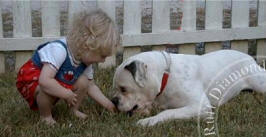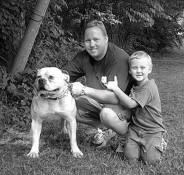|
Kids & Dogs
Ruff Diamond American Bulldogs
has supplied this information to you in order to help protect your family
and others when around dogs
Please read this with your kids
and make sure they know how and what to expect from a dog. Please keep
your dog and children safe at all times.

Things to
Remember with Dogs (and All Animals)
-
Ask permission before
petting someone else’s dog.
-
Leave mother animals and
their young alone.
-
Do not try to pet dogs that
are tied up, sleeping, eating, behind fences, or in vehicles.
-
Do not chase or tease dogs,
or pull their ears or tails.
-
Do not grab their food,
bones or toys.
-
Do not try to stop a fight.
Call an adult for help.
-
Always act kindly and
gently. Animals have feelings too.
-
Report the details of
injured, stray and threatening animals to an adult who will call the
appropriate authorities.
-
Never strike a dog
-
Never get into a dogs face.
This is a sign of aggression to a dog.
Guardian's
Responsibilities
Under the law, guardians
can be held liable for their dogs’ actions—including bites. You can reduce
the likelihood of your dog biting someone by observing these points:
-
Socialize
and train your dog. It is best to start while your dog is a puppy,
however, most dogs can be socialized to not be aggressive. When
training a dog please get the whole family involved and remember a
trained dog is a happy dog.
-
Do not let
your dog run loose. Provide a fenced run and leash your dog when you go
for a walk. Avoid having young children walk dogs they cannot control.
-
When you
meet children while out for a walk, be sure they approach your dog
properly. This ensures their safety as well as protecting your dog.
Stop children from running up on a dog this may startle the dog.
-
Teach
children to observe the simple rules of safe and considerate behavior
around dogs. In particular, teasing, chasing and yelling should be
discouraged. Your dog may tolerate it, but another may not;
-
Choose your
dog carefully. Pups should be evaluated in light of the parent dogs’
behavior. Select dogs that have been bred to be non-aggressive family
dogs.
-
Do not leave
babies or very young children alone with a dog, always monitor play
time.
-
Children should be taught to
never hug a strange dog. Many dogs tolerate such behavior but others
don’t.
-
Never leave a dog chained,
the dog or children can be injured.
-
When feeding your dog always
have the children involved this will instill pack order with your dog.
-
Never let your dog walk
through a door before you, this also instills pack order.
-
Remember
that your dog or any dog is an animal you never know what they are
thinking so you should always be alert.
-
When walking
your dog always be aware of people around you and your surroundings.
Keep your dog close when people approach.

Why Dogs Bite
-
The vast majority of dogs are
safe, reliable companions. But even a friendly dog may bite if
threatened, angry, afraid or hurt. Some dogs can be described as
dangerous—bred or trained to be aggressive, with predatory instincts
that may cause them to chase and attack a fleeing child.
-
The reality is that most dog
bites are from dogs known to the victim, either the family dog or
neighbor's dog. It is often through play that excites the dog that most
dog bites occur. It is also the case that most dog bites aren't reported
because it is the family dog or the bite is not severe enough to warrant
a hospital visit.
Dogs Protect
Things, Places and People
-
Just as humans do, dogs protect
things they care about, whether their food, puppies, or favorite toys.
They also protect spaces—their own and their guardians’. Eating and
sleeping areas, yards, porches, and parked cars are all commonly
defended by dogs. A child reaching through a fence or arriving
unannounced at the door, can turn a neighbor's warm, loyal pet into a
growling, aggressive protector. Dogs provide us with protection. We must
ensure that children understand this and are aware of situations that
may frighten or anger a dog.
Other Reasons
Dogs May Bite
-
Cornering, crowding or standing
over a dog, particularly a small one, may make it feel defensive.
Children should stand back and never put their faces close to a dog’s
mouth. The face is the most common site of serious dog bite injuries.
-
Stray dogs are in danger and may
be dangerous. Any dog that is loose may be lost, frightened or
injured—and more likely to bite.
-
Sick or injured dogs may be
afraid or irritable and should be avoided by children.
-
Elderly dogs may have impaired
vision or hearing, or more sensitive to touch which can cause them to be
more easily startled.
-
Some dogs are inadequately
socialized. Dogs living with or around children need to be able to
tolerate a degree of rough treatment without resorting to biting. Choose
your dog carefully and discourage even play-biting by puppies, to avoid
problems later.
-
Most children’s dog bite
injuries occur during play with a dog they know. A dog that is excited
or nervous can bite by mistake. Children should be taught not to play
fight, tease, yell at, or chase dogs or other animals.
-
Dogs can feel left out,
especially when a new baby or pet joins the household. Give a dog extra
love and attention at these times.
|



